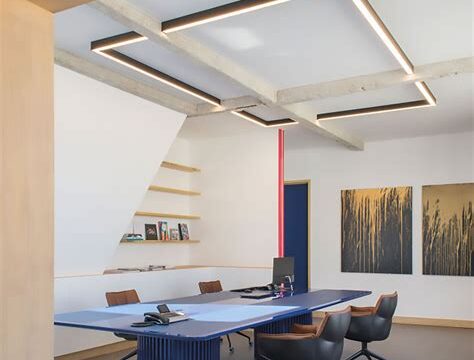Working from a home office has become more common than ever, and getting the perfect balance of lighting is crucial for productivity, comfort, and overall well-being. In this blog post, we will explore the various aspects of home office lighting and how to find the perfect balance for your workspace.
We will begin by delving into the importance of home office lighting and how it can impact your work performance and health. Then, we will assess the natural light sources in your workspace and how to make the most of them.
Choosing the right artificial lighting fixtures will also be discussed, as well as optimizing desk lamp placement for optimal visibility and using task lighting to reduce eye strain.
Additionally, we will explore ambient lighting options to create a cozy atmosphere, and how adjusting light temperature can enhance productivity and relaxation. By the end of this post, you will have a clear understanding of how to achieve the perfect balance of lighting in your home office.
Understanding the importance of home office lighting
Good lighting in a home office is essential for creating a productive and comfortable working environment. The right lighting can improve concentration, reduce eye strain, and boost overall well-being. Proper lighting is crucial for maintaining focus and productivity, especially during long working hours.
Many factors such as natural light, artificial lighting fixtures, desk lamp placement, task lighting, ambient lighting, and light temperature all play a role in creating an ideal home office lighting setup. Understanding the importance of each of these factors is key to designing a well-lit home workspace that meets your specific needs and preferences.
Without proper lighting, eye strain and fatigue can easily set in, leading to decreased productivity and discomfort. Inadequate lighting can also negatively impact mood and energy levels. Poorly lit spaces can make it difficult to stay focused and alert, making it essential to prioritize lighting when setting up a home office.
By understanding the importance of home office lighting and implementing the right strategies, it is possible to create a workspace that is conducive to productivity, comfort, and overall well-being.
Assessing natural light sources in your workspace
Assessing the natural light sources in your workspace is crucial for creating a productive and healthy environment. Natural light has been proven to have numerous benefits, such as boosting mood, increasing productivity, and reducing eye strain. By understanding the natural light sources in your workspace, you can optimize your work area for optimal well-being and efficiency.
One way to assess the natural light sources in your workspace is to take note of the positioning of windows and doors. Determine the direction they face and how much natural light they let in during different times of the day. This will give you a better understanding of when and where the natural light is most prevalent in your workspace.
It’s also important to consider any obstructions that may be blocking natural light from entering your workspace. Are there large buildings, trees, or other structures outside your windows that could be obstructing natural light? By identifying and addressing these obstructions, you can maximize the amount of natural light in your workspace.
Additionally, consider the quality of the natural light in your workspace. Is it harsh and glaring, or soft and diffused? The quality of natural light can significantly impact your comfort and productivity. If the natural light in your workspace is too harsh, consider using curtains, blinds, or other window treatments to diffuse the light and create a more comfortable work environment.
Choosing the right artificial lighting fixtures
When setting up a home office, it’s important to carefully consider the artificial lighting fixtures you choose. The right lighting can make a significant impact on your productivity and overall well-being. Artificial lighting fixtures come in a variety of types, including overhead lights, floor lamps, and desk lamps. It’s essential to select the right fixtures for your space to ensure that you have adequate and efficient lighting throughout the day.
When it comes to choosing the right artificial lighting fixtures, consider the type of work you’ll be doing in your home office. If you need focused and direct lighting, a desk lamp with an adjustable arm and brightness settings may be the best option. On the other hand, if you require ambient lighting to create a pleasant and inviting atmosphere, a floor lamp or overhead lighting fixture may be more suitable.
Another factor to consider when choosing artificial lighting fixtures is the color temperature of the bulbs. It’s important to select bulbs with the right color temperature to promote productivity and relaxation. Cool white light is ideal for tasks that require concentration and focus, while warm white light is better for creating a cozy and comfortable environment.
Furthermore, consider the energy efficiency of the lighting fixtures you choose. Energy-efficient fixtures not only help reduce your carbon footprint but can also save you money on your monthly utility bills. Look for fixtures with LED bulbs, which are known for their long lifespan and low energy consumption.
Optimizing desk lamp placement for optimal visibility
When it comes to creating a productive and comfortable workspace, proper lighting is essential. Desk lamps play a crucial role in providing focused light for tasks such as reading, writing, and using electronic devices. However, to truly optimize desk lamp placement for optimal visibility, there are a few key considerations to keep in mind.
First and foremost, it’s important to position your desk lamp in a way that minimizes glare and shadows. Placing the lamp to the side of your dominant hand can help reduce shadows on the work surface, making it easier to see and work effectively. Additionally, positioning the lamp at a height that allows the light to shine directly onto the task at hand can further enhance visibility and reduce eye strain.
Another factor to consider when optimizing desk lamp placement is the type of light bulb being used. Choosing a bulb with the right color temperature can make a significant difference in the quality of light provided by the lamp. For tasks that require close attention to detail, such as reading or paperwork, a cool white or daylight bulb can provide the necessary brightness and clarity.
Finally, taking into account the overall ambient lighting in your workspace is important when optimizing desk lamp placement. If the room is already well-lit with natural or overhead lighting, you may be able to position the desk lamp in a way that complements the existing light sources, rather than relying solely on the desk lamp for illumination.
Using task lighting to reduce eye strain
When working long hours at a desk, eye strain can become a major issue. One effective way to reduce eye strain is by utilizing task lighting. Task lighting is a localized light source that is specifically designed to provide focused illumination for close-up activities such as reading, writing, or working on a computer.
It is important to position task lighting strategically to minimize glare and shadow. For example, placing a desk lamp directly behind the computer screen can help reduce the contrast between the bright screen and the surrounding area, thereby reducing eye strain.
Another method to reduce eye strain is to use adjustable task lighting fixtures, such as desk lamps with adjustable arms or swivel heads. This allows users to customize the direction and intensity of the light to suit their specific needs, reducing the strain on their eyes.
By incorporating task lighting into your workspace, you can create a more comfortable and ergonomic environment, reducing the risk of eye strain and enhancing productivity.
Exploring ambient lighting options for a cozy atmosphere
Creating a welcoming and cozy atmosphere in your home office is essential for productivity and overall well-being. One way to achieve this ambiance is through the use of ambient lighting. Ambient lighting, also known as general lighting, provides overall illumination and sets the mood for a room. There are various options for ambient lighting that can contribute to a warm and inviting workspace.
One popular option for ambient lighting is the use of floor lamps. These lamps come in a variety of styles and designs, allowing you to find the perfect fit for your home office. The soft glow emitted from a floor lamp can create a calming atmosphere, making it an ideal choice for those looking to add a cozy touch to their workspace.
Another ambient lighting option to consider is LED strip lights. These versatile lights can be installed under shelves, cabinets, or along the edges of the room to provide soft, indirect illumination. LED strip lights come in various colors and can be dimmed to create the perfect ambiance for your home office.
For a more natural feel, consider incorporating hanging pendant lights into your workspace. These lights can add a touch of elegance and warmth to the room, creating a cozy environment that is both functional and visually appealing. With the flexibility to adjust the height and placement of pendant lights, you can customize the lighting to suit your needs.
Adjusting light temperature for productivity and relaxation
When it comes to creating an optimal work environment at home, adjusting the light temperature can play a significant role in enhancing productivity and promoting relaxation. The color temperature of light can have a direct impact on our mood, energy levels, and overall well-being. By understanding the different light temperatures and how they affect us, we can make informed decisions about the lighting in our workspace.
Choosing the right color temperature for your home office is crucial. Cooler light, such as blue and white tones with higher color temperatures, can help boost alertness and concentration, making it suitable for tasks that require focus and mental acuity. On the other hand, warmer light, with yellow and orange tones and lower color temperatures, promotes a sense of calm and relaxation, making it ideal for winding down at the end of the day.
It’s important to consider the time of day and the activities you’ll be engaging in when adjusting the light temperature. For instance, in the morning, you may benefit from cooler light to kickstart your day and increase productivity. As the day progresses and you begin to wind down, transitioning to warmer light can help signal to your body that it’s time to relax and prepare for rest.
With the availability of smart lighting systems, you can easily adjust the light temperature in your home office to align with your daily routine. By creating a schedule that mimics natural daylight transitions, you can maintain a harmonious balance between productivity and relaxation throughout the day. By being mindful of the light temperature in your workspace, you can create an environment that supports your well-being and enhances your overall work experience.





